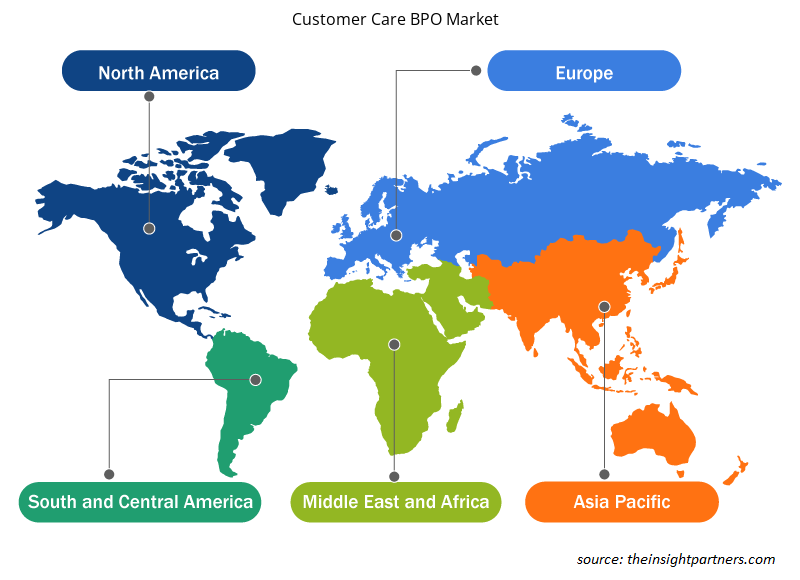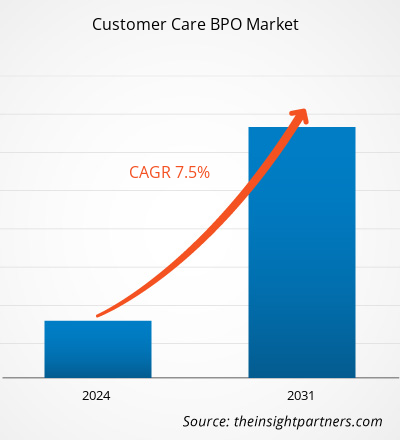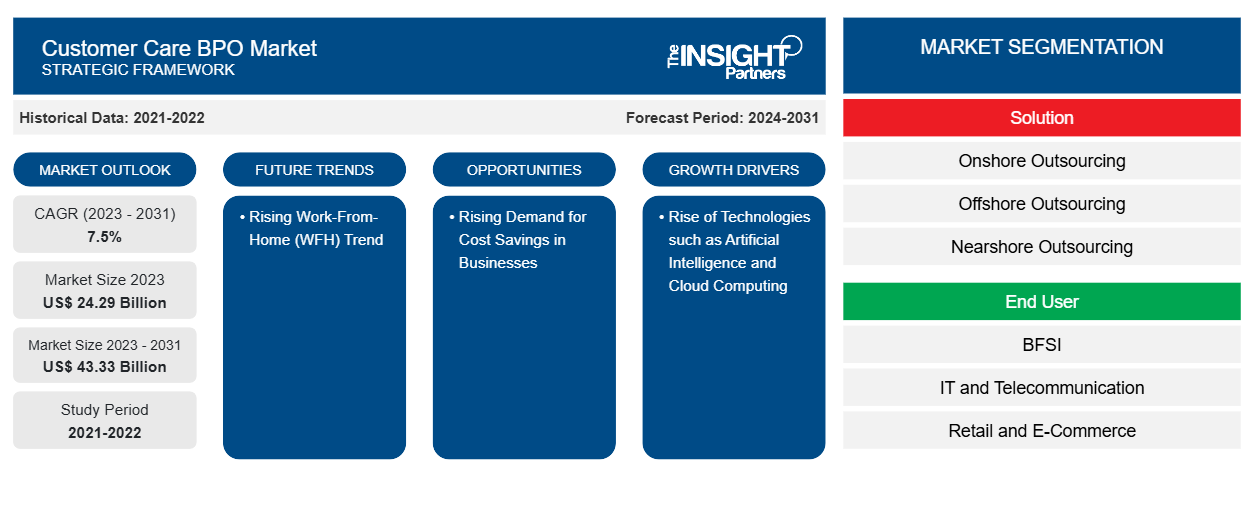Le marché du BPO de service client devrait atteindre 43,33 milliards USD d'ici 2031, contre 24,29 milliards USD en 2023. Le marché devrait enregistrer un TCAC de 7,5 % au cours de la période 2023-2031. La mise en œuvre croissante de l'IA devrait rester une tendance clé du marché.
Analyse du marché du BPO du service client
L'externalisation du service client consiste à utiliser des services tiers pour gérer les interactions avec les clients à toutes les étapes de l'achat, de l'achat et de l'après-achat. Ces services sont fournis via différents canaux, notamment le site Web, le courrier électronique ou la messagerie, le téléphone, le chat en ligne en direct, les réseaux sociaux et les SMS ou les messages. L'utilisation de ces solutions multicanaux aide les entreprises d'externalisation à fournir efficacement leurs services. La croissance du marché de l'externalisation du service client est facilitée par la tendance croissante du travail à domicile (WFH) dans des secteurs tels que l'informatique et les télécommunications et le BFSI. Cette tendance offre aux acteurs du marché des opportunités d'innover et de développer de nouveaux modèles de prestation.
Aperçu du marché du BPO du service client
Les services d'externalisation des processus métier (BPO) impliquent principalement la gestion de l'externalisation des processus métier pour répondre aux besoins d'un client. Ces services sont responsables d'opérations commerciales spécifiques. Les fonctions d'entreprise les plus couramment externalisées comprennent les opérations de back-office telles que la comptabilité et les finances, les ressources humaines et les services d'assistance à la clientèle. Les sous-traitants de services clients (BPO) ont le potentiel de dynamiser considérablement les entreprises en offrant un service client et des connaissances spécialisées qui aident les entreprises à attirer et à fidéliser leurs clients.
Personnalisez ce rapport en fonction de vos besoins
Vous bénéficierez d'une personnalisation gratuite de n'importe quel rapport, y compris de certaines parties de ce rapport, d'une analyse au niveau des pays, d'un pack de données Excel, ainsi que de superbes offres et réductions pour les start-ups et les universités.
-
Obtenez les principales tendances clés du marché de ce rapport.Cet échantillon GRATUIT comprendra une analyse de données, allant des tendances du marché aux estimations et prévisions.
Facteurs moteurs et opportunités du marché de l'externalisation du service client
L'essor des technologies telles que l'intelligence artificielle et le cloud computing favorise le marché
L’intégration croissante de l’intelligence artificielle (IA) dans les services d’externalisation des processus métier (BPO) de service client a été favorisée par l’évolution technologique, la transformation numérique et la pandémie de COVID-19. Cette intégration a permis aux fournisseurs de services d’améliorer les communications en temps réel avec les clients, révolutionnant ainsi la façon dont les marques communiquent avec leur public. L’IA, ainsi que le cloud computing, ont permis de combler le fossé entre la grande quantité de données générées et la capacité à utiliser ces données pour interagir avec les clients en temps réel. Cette intégration a permis aux entreprises de BPO d’offrir une assistance 24h/24 et 7j/7, de résoudre des problèmes simples et de personnaliser leurs services. Dans les activités de vente, l’IA a facilité la personnalisation et la mise à l’échelle du processus de vente.
La reconnaissance vocale basée sur l’IA, les assistants virtuels et les réponses vocales interactives ont considérablement réduit le temps d’attente des clients avant de joindre un responsable du service client. De plus, le rôle du routage omnicanal basé sur l’IA a permis une commutation transparente entre plusieurs canaux, tels que les chats et les appels vocaux, les dirigeants étant toujours prêts à répondre aux questions ou aux réclamations des clients. Les BPO intelligents intégrés à l’IA ont aidé les entreprises à optimiser et à automatiser leurs services, ce qui a donné lieu à des processus commerciaux plus rentables, plus respectueux de l’environnement et plus efficaces. Par conséquent, l’émergence de technologies telles que l’intelligence artificielle et le cloud computing devrait stimuler la croissance du marché du BPO du service client dans les années à venir.
Demande croissante de réduction des coûts dans les entreprises
L’externalisation du service client peut permettre de réduire considérablement les coûts. En effet, les entreprises d’externalisation des processus métier (BPO) du service client disposent déjà d’une infrastructure établie et d’une efficacité opérationnelle, ce qui élimine le besoin d’espace de bureau supplémentaire, d’équipement, de coûts de formation et d’autres dépenses connexes nécessaires à l’intégration des agents de support dans un bureau à domicile. Cependant, un partenariat avec une BPO de service client peut aider à éliminer ces coûts, car elle dispose déjà de l’infrastructure et de l’efficacité opérationnelle nécessaires. Cela leur permet d’offrir un support de haute qualité à un coût réduit par rapport au maintien d’une équipe interne, la principale préoccupation étant l’intégration de BPO. En outre, les organisations peuvent souvent réaliser des économies de coûts plus importantes en collaborant avec une BPO offshore qui utilise des agents internationaux. Cela peut être remarquablement avantageux pour les organisations à la recherche d’un support client multilingue.
Analyse de segmentation du rapport sur le marché des BPO de service client
Les segments clés qui ont contribué à l’élaboration de l’analyse du marché du BPO du service client sont le déploiement, la taille de l’organisation et l’application.
- En fonction des solutions proposées, le marché est segmenté en externalisation onshore, externalisation offshore et externalisation nearshore. Le segment de l'externalisation onshore détenait une part de marché importante en 2023.
- En termes d'utilisateur final, le marché est divisé en BFSI, IT et télécommunications, vente au détail et commerce électronique , fabrication, soins de santé et produits pharmaceutiques, transport et logistique, médias et communication, automobile, etc. Le segment de l'informatique et des télécommunications détenait une part substantielle du marché en 2023.BFSI, IT and telecommunication, retail and
Analyse des parts de marché du BPO du service client par zone géographiqueBPO Market Share Analysis by Geography
La portée géographique du rapport sur le marché BPO du service client est principalement divisée en cinq régions : Amérique du Nord, Asie-Pacifique, Europe, Moyen-Orient et Afrique, et Amérique du Sud et centrale.BPO market report is mainly divided into five regions: North America, Asia Pacific, Europe, Middle East & Africa, and South & Central America.
Le marché de l'externalisation des processus clients en Amérique du Nord est divisé entre le Canada, les États-Unis et le Mexique. Nous détenons la plus grande part de ce marché en Amérique du Nord. La présence de nombreuses grandes entreprises aux États-Unis, telles que Microsoft Corporation, Apple Inc., Proctor & Gamble et General Motors, a entraîné une demande accrue de représentants du service client pour répondre aux divers besoins des clients. Selon le Bureau of Labor Statistics des États-Unis, plus de 2 890 000 personnes étaient employées comme représentants du service client aux États-Unis en 2021. Les États-Unis sont connus pour leurs avancées technologiques, l'adoption précoce de technologies avancées et la présence de diverses entreprises technologiques, y compris des petites et moyennes entreprises (PME) et des grandes entreprises. Cela a contribué à l'évolution exponentielle du pays.BPO market in North America is divided into Canada, the US, and Mexico. We hold the largest share of this market in North America. The presence of numerous large companies in the US, such as Microsoft Corporation, Apple Inc., Proctor & Gamble, and General Motors, has led to an increased demand for customer service representatives to meet various customer needs. According to the US Bureau of Labor Statistics, more than 2,890,000 people were employed as customer service representatives in the US in 2021. The US is known for its technological advancement, early adoption of advanced technologies, and the presence of various tech firms, including both small and medium enterprises (SMEs) and large enterprises. This has contributed to the country's exponential evolution.
Aperçu régional du marché de l'externalisation des processus de service client
Les tendances et facteurs régionaux influençant le marché du BPO du service client tout au long de la période de prévision ont été expliqués en détail par les analystes d'Insight Partners. Cette section aborde également les segments et la géographie du marché du BPO du service client en Amérique du Nord, en Europe, en Asie-Pacifique, au Moyen-Orient et en Afrique, ainsi qu'en Amérique du Sud et en Amérique centrale.

- Obtenez les données régionales spécifiques au marché BPO du service client
Portée du rapport sur le marché de l'externalisation des processus de service client
| Attribut de rapport | Détails |
|---|---|
| Taille du marché en 2023 | 24,29 milliards de dollars américains |
| Taille du marché d'ici 2031 | 43,33 milliards de dollars américains |
| Taux de croissance annuel composé mondial (2023-2031) | 7,5% |
| Données historiques | 2021-2022 |
| Période de prévision | 2024-2031 |
| Segments couverts |
Par Solution
|
| Régions et pays couverts |
Amérique du Nord
|
| Leaders du marché et profils d'entreprises clés |
|
Densité des acteurs du marché du BPO de service client : comprendre son impact sur la dynamique commerciale
Le marché du BPO de service client connaît une croissance rapide, tirée par la demande croissante des utilisateurs finaux en raison de facteurs tels que l'évolution des préférences des consommateurs, les avancées technologiques et une plus grande sensibilisation aux avantages du produit. À mesure que la demande augmente, les entreprises élargissent leurs offres, innovent pour répondre aux besoins des consommateurs et capitalisent sur les tendances émergentes, ce qui alimente davantage la croissance du marché.
La densité des acteurs du marché fait référence à la répartition des entreprises ou des sociétés opérant sur un marché ou un secteur particulier. Elle indique le nombre de concurrents (acteurs du marché) présents sur un marché donné par rapport à sa taille ou à sa valeur marchande totale.
Les principales entreprises opérant sur le marché du BPO du service client sont :
- Alorica Inc
- Telus International Cda Inc
- Simplement Contacter International
- Comdata S.A.
- Concentrix Corp
- Fondateur de la société d'exploitation
Avis de non-responsabilité : les sociétés répertoriées ci-dessus ne sont pas classées dans un ordre particulier.

- Obtenez un aperçu des principaux acteurs du marché du BPO du service client
Actualités et développements récents du marché du BPO dans le domaine du service client
Le marché du BPO de service client est évalué en collectant des données qualitatives et quantitatives après des recherches primaires et secondaires, qui incluent d'importantes publications d'entreprise, des données d'association et des bases de données. Quelques-uns des développements sur le marché du BPO de service client sont répertoriés ci-dessous :
- Solera, leader mondial de la gestion du style de vie des véhicules, a présenté aujourd'hui son offre de services BPO, XpertCX Solutions Suite. Conçue pour redéfinir l'expérience client, cette suite innovante offre une approche holistique des services BPO, offrant un support de bout en bout dans l'ensemble du secteur automobile. En combinant de manière transparente une technologie de pointe avec une expertise chevronnée, XpertCX Solutions Suite vise à rationaliser les opérations, à amplifier l'efficacité et à accroître la satisfaction des clients dans l'ensemble du secteur. De plus, alors que Solera continue de donner la priorité à la croissance de XpertCX Solutions Suite et de sa branche BPO, la société inaugurera un nouvel espace de bureau le 27 mars, destiné à accueillir plus de 400 employés du service client à Jacksonville, en Floride.
(Source : Solera, Communiqué de presse, mars 2024)
Rapport sur le marché de l'externalisation des processus de service client et livrables
Le rapport « Taille et prévisions du marché du BPO du service client (2021-2031) » fournit une analyse détaillée du marché couvrant les domaines ci-dessous :
- Taille et prévisions du marché BPO du service client aux niveaux mondial, régional et national pour tous les segments de marché clés couverts par le périmètre
- Tendances du marché BPO du service client ainsi que dynamique du marché telles que les facteurs déterminants, les contraintes et les opportunités clés
- Analyse détaillée des cinq forces de PEST/Porter et SWOT
- Analyse du marché BPO du service client couvrant les principales tendances du marché, le cadre mondial et régional, les principaux acteurs, les réglementations et les développements récents du marché
- Analyse du paysage industriel et de la concurrence couvrant la concentration du marché, l'analyse de la carte thermique, les principaux acteurs et les développements récents pour le marché BPO du service client
- Profils d'entreprise détaillés
- Analyse historique (2 ans), année de base, prévision (7 ans) avec TCAC
- Analyse PEST et SWOT
- Taille du marché Valeur / Volume - Mondial, Régional, Pays
- Industrie et paysage concurrentiel
- Ensemble de données Excel
Rapports récents
Témoignages
Raison d'acheter
- Prise de décision éclairée
- Compréhension de la dynamique du marché
- Analyse concurrentielle
- Connaissances clients
- Prévisions de marché
- Atténuation des risques
- Planification stratégique
- Justification des investissements
- Identification des marchés émergents
- Amélioration des stratégies marketing
- Amélioration de l'efficacité opérationnelle
- Alignement sur les tendances réglementaires























 Obtenez un échantillon gratuit pour - Marché de l'externalisation des processus de service client
Obtenez un échantillon gratuit pour - Marché de l'externalisation des processus de service client